|
|
Gum trees dot the hills and valleys of south-eastern Australia, a vivid fixture of the rolling landscape. But despite the seeming health of these iconic trees, they have earned the morbid nickname “the living dead” among ecologists, who say natural changes and human actions are threatening the next generation of gum trees.
The gum trees that are scattered through the landscape are naturally dying off at a rate of one to two percent each year. With no replacement, researchers fear more than 100,000 square kilometers of land could be virtually treeless within the next 100 years.
“If you took an aerial photo of this, it wouldn’t look that bad,” said Joern Fischer, an ecologist at the Australian National University, gesturing to a panorama of White and Yellow Box eucalypts, two of the most widespread tree species. “But once you take a closer look at it you’ll see that we haven’t had any regeneration or any young trees. All we have are old trees or dying trees.”
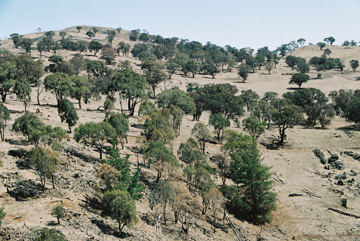 Scattered trees. (High resolution). Photo by Jeff Novich. |
The ‘sheep-wheat belt,’ stretching hundreds of kilometers along eastern Australia, was once an extensive area of grassy woodlands with almost continuous tree cover. But European settlement 150 years ago cleared and converted most of it to pastures for grazing. Many of the surviving trees are now scattered loosely across the landscape, with crowns sometimes hundreds of meters apart.
Following bursts of active tree clearing to ‘improve’ the country during the early phases of settlement, in recent years farmers have mostly left the remaining trees alone. But continued pressure from livestock grazing stands to be a force as destructive as the axe.
Losing scattered trees could have a devastating impact on the ecosystem, as they play a central role in water infiltration, nutrient cycling and supporting local animals like insects and bats. Even the dead gum trees are critical, because the hollows that form in them provide nesting sites for birds. But their importance goes beyond that.
Total tree cover is often as little as 5 percent and rarely more than 15 percent. But some studies suggest that a total tree cover of at least 30 percent in a formerly wooded area is the minimum required to avoid major long-term ecological consequences.
“If you don’t have trees, you really don’t have a lot because they’re such an obvious starting point for all kinds of things,” said Fischer, noting that without the gum trees, the paddocks will support little biodiversity.
|
WATCH VIDEO |
The scattered gum trees provide a home for a multitude of species including more than 40 species of birds such as the Scarlet Robin and the Brown Treecreeper. “At the landscape scale, we actually have scattered trees fulfilling an important connectivity function because birds and bats and things like that move through the landscape using quite large areas, and scattered trees actually help them move through the landscape.”
Experts say the biggest threat to the gum trees comes from agricultural practices. When a farmer lets his livestock graze the pastures continuously and adds fertilizer to promote growth, native species die off because they take too long to grow back. Exotic or “invasive” species, like the annual legumes and grasses such as ratstail fescue, which farmers intentionally seed, rapidly take over. These species crowd out both native grasses and seedlings of trees that might have otherwise begun to grow. New trees don’t stand much of a chance.
“This area is one of the most stressed parts of Australia in terms of biodiversity loss,” said Josh Dorrough, an ecologist at Victoria’s Arthur Rylah Institute for Environmental Research.
Though agriculture is threatening the gum trees and other species, altering these damaging practices could threaten another endangered species: the Australian farmer.
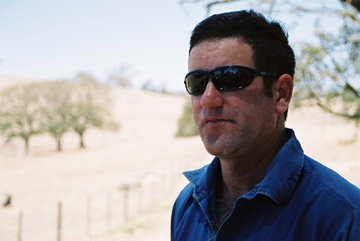 Stephen Boyd. (High resolution). Photo by Jeff Novich. |
According to the Australian Department of Foreign Affairs and Trade, Australia leads the world in wool exports, is second only to Brazil in beef exports, and grows nearly a sixth of the world’s wheat, thanks in part to the productivity of these massive farmlands. To remain profitable under economic pressures such as volatile wool prices and severe drought, farmers must get the most out of their land. Traditionally, farmers apply fertilizer and graze year-round. That constant pressure eventually kills off the native, perennial species, the species that naturally thrive in this dry landscape.
“Imagine every summer you’re trying to grow and you get a little bit of rain and then an animal comes along and chews you down,” Dorrough said. “Eventually you die. It might take 10 years or 20 years but that’s the inevitable outcome. You add onto that droughts which exacerbate the problem and you end up with bare ground.”
Already at least one species is feeling the effect of the disappearance of trees.
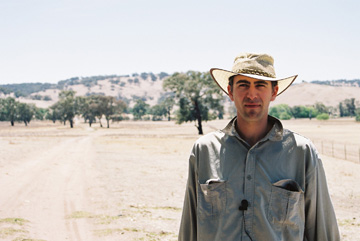 Joern Fischer. (High resolution). Photo by Jeff Novich. |
In the 1980s, researchers noticed a decline in the population of the Superb Parrot, a radiant, grass-green bird that nests in the hollows of scattered trees. They discovered that the number of hollows, holes in the trunks of old or dead trees, was also declining, causing increased competition for nest hollows from starlings, or even bees.
The parrot, official emblem of Boorowa Shire, is currently listed as “vulnerable,” the most serious category before “endangered” by Australia’s Department of the Environment and Water Resources.
There are an estimated 6,500 pairs of breeding superb parrots left in Australia.
“As the number of trees decreases over time, there’s going to be more competition for that resource [hollows], for nesting,” said Adrian Manning, a landscape ecologist at the Australian National University who studies the superb parrot. “So that may be an issue already in some places, but we can see that that’s going to be exacerbated through time.”
To make sure the birds don’t lose all their breeding spots, new trees have to start growing soon, Manning said. “Hollows take about a hundred years or more to develop, so we need to act urgently now to address this issue so we don’t have a problem in the future, so we don’t have a bottleneck,” he said.
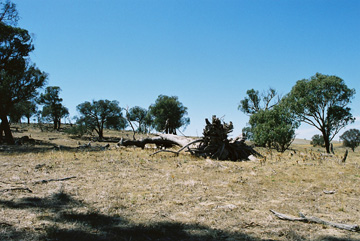 Scattered trees. (High resolution). Photo by Jeff Novich. |
Grazing livestock is the money-maker on these landscapes, and farmers like Stephen Boyd are common. He manages an 18,000 acre farm near Boorowa, about 4 hours southwest of Sydney. Boyd said a recent drought has forced him to cut the number of sheep and cattle in half, to 18,000 sheep and 700 cattle. Each week he rides around the 80 kilometer perimeter on a motorcycle monitoring animal health, noting the falling level of water in his dams (half are already dry), and carting 60 tons of hay and grain to hand-feed the livestock.
To provide enough income at a time of narrow profit margins, many farmers allow their livestock to graze the land until it is mostly barren while regularly employing fertilizers, typically once every few years, to enhance plant growth. This combination of management practices might work in the short term, but eventually the ground becomes barren.
Plants provide a protective layer that lessens the impact of raindrops, and tree roots hold the soil together. Without these, the topsoil is washed away when the rain eventually does come.
It may not be a sustainable approach in the long-run. But farmers like Boyd say they have no choice.
“Farming is a business just like any other business,” Boyd said. “I’m put under pressure by the owners of the property to keep it viable and profitable.”
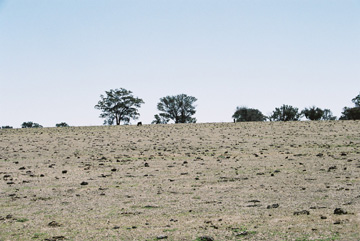 Scattered trees landscape. (High resolution). Photo by Jeff Novich. |
Fearing that continuing current practices will eventually destroy their land, other farmers have taken an alternative approach in recent years. These farmers value the health of their land more than their livestock, if it comes down to choosing between the two.
Gary Johnson, another farmer near Boorowa, has an unorthodox outlook about his land.
In 2002, Johnson decided to take radical steps to preserve the long-term health of his land, even if it meant substantial reductions in stocking rates. He set a goal to maintain 100 percent grass cover 100 percent of the time, regardless of the cost. Similarly, when a tree dies, many farmers knock it over and clean it up. Johnson leaves everything the way it is to promote natural diversity. He reasons that, ultimately, his land holds all the value in his farm. The livestock can be bought or sold if times change, but the land is irreplaceable.
In the spring of 2006, in the midst of one of the most severe droughts in many years, he noticed his land was deteriorating to a critical point and took action.
“We had to do something that I’ve never done before and that is to de-stock to achieve that goal,” Johnson said of selling off his sheep and cattle. “Our landscape is the most important thing to us.”
He has no future income stream at the moment, but plans to restock as soon as he thinks his land can handle the grazing.
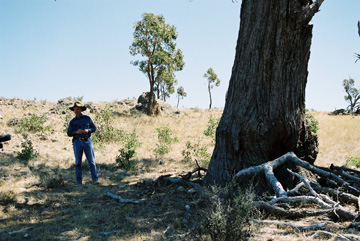 Gary Johnson. (High resolution). Photo by Jeff Novich. |
In addition to allowing invasive plant species to thrive, intensive grazing of cattle and sheep also limits the ability of the scattered gum trees to regenerate.
A tree produces seeds, and the ones that aren’t eaten by insects are blown away from the tree. They end up in soil and, given sufficient nutrients and rain, take root. But because the pastures are heavily grazed, especially under dry conditions where there grass is limited, seedlings get eaten by sheep or cattle long before they have a chance to grow big enough to withstand grazing.
With Australian farmers suffering one of the worst droughts in years, however, concerns about the long-term health of the land have been overshadowed by economic concerns. For Boyd, worrying about scattered trees is not as immediate a priority as making sure the livestock are fed.
Beyond easing the grazing pressures on the land, farmers can also help to maintain scattered trees by planting them. Guy Fitzhardinge, a farmer near the town of Cowra, said he wants to develop a system to plant perhaps 15 new trees per year. He sees this as a long-term investment.
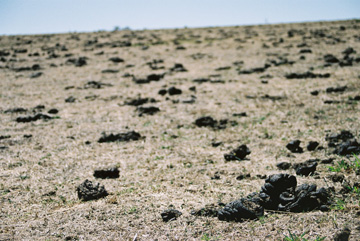 Piles of dung. (High resolution). Photo by Jeff Novich. |
“It’s not a big job, but if you put in that number of trees year after year, the thing is you can make some pretty big changes and it’s not a terribly expensive thing to do,” he said.
Planting seedlings is a common practice for farmers, one that government funding has largely encouraged. But the key difference between Fitzhardinge and most farmers is the spatial pattern of the trees. Farmers often plant in straight lines along the boundary of their paddocks, a pattern that is far less useful ecologically than the semi-isolated scattered trees Fitzhardinge plants.
Dorrough, the plant ecologist, said planting trees is often not economical for a landscape this big.
“We’re spending huge amounts of money replanting trees and at present it’s not making a huge difference to the total tree cover,” Dorrough said.
The main goal should be to promote regeneration through new grazing techniques and encouraging growth of native species, Dorrough said, because while there are still trees in a paddock, they can regenerate on their own, at no cost.
Fitzhardinge never worried about scattered trees until a few years ago, when he was sitting outside one evening watching sugar gliders soar through the air from the back porch of his house to a nearby tree.
“I began to realize that if you didn’t have scattered trees that there was no way in the world that those sorts of animals were able to get around through the bush,” he said. “I think basically from an ecological point of view, it’s absolutely essential to have them because there is a number of species that depend on them.”
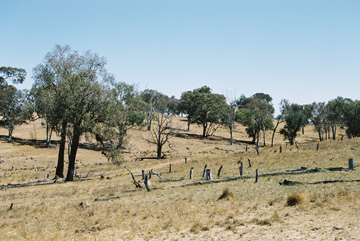 (High resolution). Photo by Jeff Novich. |
Reducing overgrazing, however, need not destroy profits, said Joern Fischer. But it will likely involve scaling back the number of head or rotating the livestock.
In the meantime, the land probably cannot sustain the current level of agriculture for much longer, Fitzhardinge says, and it will probably require scaling back grazing operations as droughts become more frequent. “I think the productivity of the landscape will have to be reevaluated because I don’t think we’ll be able to run the numbers stock that we have in the past,” he said.
Paradoxically, intensive grazing can sometimes be used as a solution to the problems of overgrazing. When exotic species begin to cover the ground, they compete for nutrients with trees that are trying to germinate. The likelihood of seedlings establishing in dense pastures of introduced grasses is very low. So some farmers have used the technique of crash grazing in these pastures in an effort to make them more habitable for seedlings – which involves putting a large number of livestock into a small area, for a short period of time.
“Grazing isn’t necessarily the problem here, it’s how we’re grazing animals,” Dorrough said. “They can be a solution as well to regeneration.”
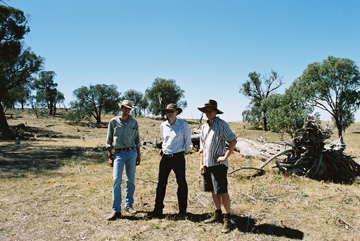 Joern Fischer, Adrian Manning, and Josh Dorrough (High resolution). Photo by Jeff Novich. |
Current research is considering different grazing regimes and trying to see which ones promote tree growth and which ones are not sustainable for the land. Some farmers may have already developed management techniques that work.
Despite the economic pressures and the drought, Dorrough said he is hopeful that there is a coming change in the consciousness of the general public and of the farmers about changing the way they operate.
“You find that most grazers want to maintain and want to improve the environment in which they live. But if you’re sitting in a situation where your farm is barely profitable, where you are trying to make a living, and you’ve got ongoing droughts, it becomes very hard to change your management,” Dorrough said. “It often requires a big trigger or a big change to allow you to make those changes.”
Jeff Novich is a freelance videographer and journalist in New York City. He recently launched VocabSushi.com, a website that helps you learn new vocab words through contextual examples from recent news articles.”